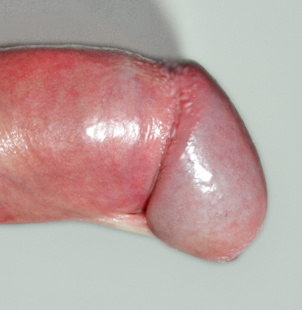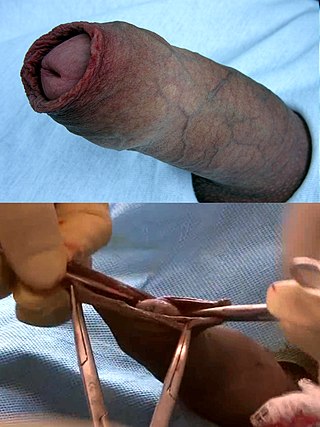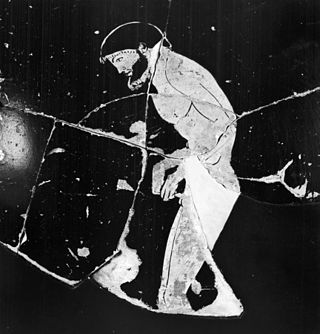
In male human anatomy, the glans penis or penile glans, commonly referred to as the glans, is the bulbous structure at the distal end of the human penis that is the human male's most sensitive erogenous zone and primary anatomical source of sexual pleasure. The glans penis is present in the male reproductive organs of humans and most other mammals where it may appear smooth, spiny, elongated or divided. It is externally lined with mucosal tissue, which creates a smooth texture and glossy appearance. In humans, the glans is located over the distal ends of the corpora cavernosa and is a continuation of the corpus spongiosum of the penis. At the summit appears the urinary meatus and at the base forms the corona glandis. An elastic band of tissue, known as the frenulum, runs on its ventral surface. In men who are not circumcised, it is completely or partially covered by a fold of skin called the foreskin. In adults, the foreskin can generally be retracted over and past the glans manually or sometimes automatically during an erection.

Genital modifications are forms of body modifications applied to the human sexual organs, such as piercings, circumcision, or labiaplasty. The term genital mutilation is generally used for genital modifications that diminish the recipient's quality of life and result in adverse health outcomes, whether physical or mental.

In female humans and other mammals, the clitoral hood is a fold of skin that surrounds and protects the glans of the clitoris; it also covers the external clitoral shaft, develops as part of the labia minora and is homologous with the foreskin in the male reproductive system. The clitoral hood is composed of mucocutaneous tissues; these tissues are between the mucous membrane and the skin, and they may have immunological importance because they may be a point of entry of mucosal vaccines.

Penis enlargement, or male enhancement, is any technique aimed to increase the size of a human penis. Some methods aim to increase total length, others the shaft's girth, and yet others the glans size. Techniques include surgery, supplements, ointments, patches, and physical methods like pumping, jelqing, and traction.

Paraphimosis is an uncommon medical condition in which the foreskin of a penis becomes trapped behind the glans penis, and cannot be reduced. If this condition persists for several hours or there is any sign of a lack of blood flow, paraphimosis should be treated as a medical emergency, as it can result in gangrene.

Phimosis is a condition in which the foreskin of the penis cannot stretch to allow it to be pulled back past the glans. A balloon-like swelling under the foreskin may occur with urination. In teenagers and adults, it may result in pain during an erection, but is otherwise not painful. Those affected are at greater risk of inflammation of the glans, known as balanitis, and other complications.
The preputial mucosa of the penis is the epithelium of the inside of the prepuce, or foreskin. To differentiate it from the cutaneous skin of the outside of the prepuce, it is sometimes referred to as the inner mucosa. It starts at the ridged band of the prepuce and continues to the coronal sulcus, where it meets the epithelium of the glans and penile shaft. The preputial mucosa is devoid of hair, as is the cutaneous surface.
Penile cancer, or penile carcinoma, is a cancer that develops in the skin or tissues of the penis. Symptoms may include abnormal growth, an ulcer or sore on the skin of the penis, and bleeding or foul smelling discharge.

Balanitis is inflammation of the glans penis. When the foreskin is also affected, the proper term is balanoposthitis. Balanitis on boys still in diapers must be distinguished from redness caused by ammoniacal dermatitis. The word balanitis is from the Greek βάλανοςbalanos, literally meaning 'acorn', used because of the similarity in shape to the glans penis.

Frenulum breve, or short frenulum, is a condition in which the frenulum of the penis, which is an elastic band of tissue under the glans penis that connects to the foreskin and helps contract it over the glans, is too short and thus restricts the movement of the foreskin. The frenulum should normally be sufficiently long and supple to allow for the full retraction of the foreskin so that it lies smoothly back on the shaft of the erect penis.
Circumcision likely has ancient roots among several ethnic groups in sub-equatorial Africa, Egypt, and Arabia, though the specific form and extent of circumcision has varied. Ritual male circumcision is known to have been practiced by South Sea Islanders, Aboriginal peoples of Australia, Sumatrans, Incas, Aztecs, Mayans and Ancient Egyptians. Today it is still practiced by Jews, Muslims, Coptic Christians, Ethiopian Orthodox, Eritrean Orthodox, Druze, Samaritans and some tribes in East and Southern Africa, as well as in the United States, South Korea and Philippines.

A restoration device is a device used for applying tension to skin during the process of non-surgical foreskin restoration. Those who use such a device employ the use of tissue expansion, which causes new skin to grow.

The frenulum of the penis, often known simply as the frenulum or frenum, is a thin elastic strip of tissue on the underside of the glans and the neck of the human penis. In men who are not circumcised, it also connects the foreskin to the glans and the ventral mucosa. In adults, the frenulum is typically supple enough to allow manual movement of the foreskin over the glans and help retract the foreskin during erection. In flaccid state, it tightens to narrow the foreskin opening.

Circumcision is a procedure that removes the foreskin from the human penis. In the most common form of the operation, the foreskin is extended with forceps, then a circumcision device may be placed, after which the foreskin is excised. Topical or locally injected anesthesia is generally used to reduce pain and physiologic stress. Circumcision is generally electively performed, most commonly done as a form of preventive healthcare, as a religious obligation, or as a cultural practice. It is also an option for cases of phimosis, other pathologies that do not resolve with other treatments, and chronic urinary tract infections (UTIs). The procedure is contraindicated in cases of certain genital structure abnormalities or poor general health.

In human anatomy, the penis is an external male sex organ that additionally serves as the urinary duct. The main parts are the root, body, the epithelium of the penis including the shaft skin, and the foreskin covering the glans. The body of the penis is made up of three columns of tissue: two corpora cavernosa on the dorsal side and corpus spongiosum between them on the ventral side. The urethra passes through the prostate gland, where it is joined by the ejaculatory duct, and then through the penis. The urethra goes across the corpus spongiosum and ends at the tip of the glans as the opening, the urinary meatus. It is a passage both for excretion of urine and the ejaculation of semen.

The corona of glans penis or penis crown refers to the rounded projecting border or flare that forms at the base of the glans in human males. The corona overhangs a mucosal surface, known as the neck of the penis, which separates the shaft and the glans. The deep retro-glandular coronal sulcus forms between the corona and the neck of the penis. The two sides of the corona merge on the ventral midline forming the septum glandis. The circumference of the corona is richly innervated and is described as a highly erogenous area of the glans.

A dorsal slit is a single incision along the upper length of the foreskin from the tip to the corona, exposing the glans without removing any tissue. An ancient practice, it has been a traditional custom among a number of peoples, particularly Filipinos and Pacific Islanders, probably for thousands of years.

In male human anatomy, the foreskin, also known as the prepuce, is the double-layered fold of skin, mucosal and muscular tissue at the distal end of the human penis that covers the glans and the urinary meatus. The foreskin is attached to the glans by an elastic band of tissue, known as the frenulum. The outer skin of the foreskin meets with the inner preputial mucosa at the area of the mucocutaneous junction. The foreskin is mobile, fairly stretchable and sustains the glans in a moist environment. Except for humans, a similar structure known as a penile sheath appears in the male sexual organs of all primates and the vast majority of mammals.

A penile fibula is foremost a ring, attached with a pin through the foreskin to fasten it above the glans penis. It was mainly used by ancient Roman culture, though it may have originated earlier. This ring type of fibula has been described akin to a "large modern safety pin". Its usage may have had several reasons, for example to avoid intercourse, to promote modesty or the belief that it helped preserve a man's voice. Some Jews also utilized fibulas to hide that they were circumcised. The word fibula could also be used in general in Rome to denote any type of covering of the penis for the sake of voice preservation or sexual abstinence, it was often used by masters on their slaves for this purpose. Fibulas were frequent subject of ridicule among satirists in Rome.

The penile raphe is a visible line or ridge of tissue that runs on the ventral (urethral) side of the human penis beginning from the base of the shaft and ending in the prepuce between the penile frenulum. The line is typically darker than the rest of the shaft skin, even though its shape and pigmentation may vary greatly among males. The penile raphe is part of a broader line in the male reproductive organs, that runs from the anus through the perineum and continues to the scrotum and penis, collectively referred to as median raphe. The penile raphe is homologous to the female labia minora.






















